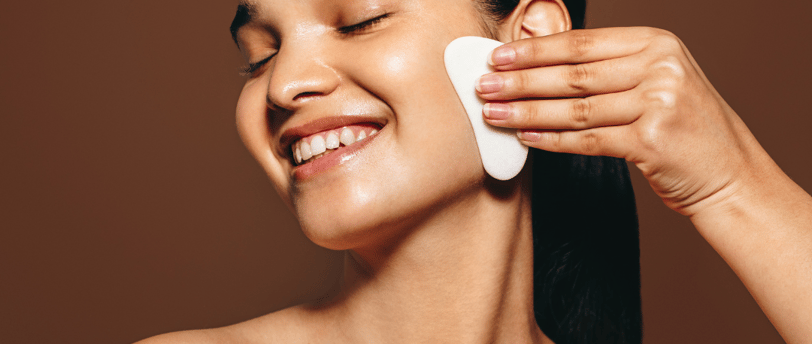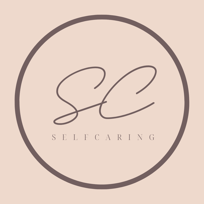Gua Sha: Nature's Botox for a Snatched Jawline
Looking for a natural way to lift, sculpt, and glow, without a single needle or appointment? Enter Gua Sha, the ancient beauty ritual that's taking modern skincare by storm. With just a smooth stone and the right technique, this centuries-old practice can help you achieve that snatched jawline, radiant skin, and a moment of daily self-care your face (and soul) will thank you for.
SELFCARE & BEAUTY
4/15/20254 min read


Introduction to Gua Sha: Origins and Benefits
Gua Sha, a traditional practice rooted in Chinese medicine, has captured the attention of the beauty industry for its remarkable skin-enhancing capabilities. Originating centuries ago, this technique involves the use of a flat-edged tool, often made from jade, rose quartz, or other natural stones, to gently scrape the skin. The movement is not merely for surface-level effects; it is designed to stimulate microcirculation, promote lymphatic drainage, and release muscle tension. As a result, many people now refer to gua sha as a natural alternative to invasive cosmetic procedures, likening its effects to those of Botox.
In its traditional context, gua sha serves medicinal purposes, aimed at alleviating pain and promoting overall wellness. Practitioners utilize the scraping technique to help disperse stagnant energy, or "qi," in the body, which is believed to cause various ailments. Over the years, this ancient practice has evolved and adapted to meet the demands of modern skincare enthusiasts, who have begun to appreciate its benefits not only for treating larger health issues but also for enhancing beauty and radiance.
Main benefits of gua sha include improved blood circulation, which provides the skin with a natural glow, and enhanced lymphatic drainage that effectively reduces puffiness. Users frequently notice a lifting effect as muscle tightness dissipates, leading to a more contoured jawline and cheekbone structure. Furthermore, the practice can help in reducing the appearance of fine lines and wrinkles through increased collagen production stimulated by the method. With its simple application and profound results, it is no wonder that gua sha has become a beloved ritual among skincare aficionados.
Pros and Cons of Gua Sha
Gua sha is increasingly recognized as an effective modality for achieving a contoured and snatched jawline, and it comes with a number of advantages. One of its most significant pros is its natural and non-invasive nature. Unlike surgical procedures or injectables, gua sha utilizes simple tools made from materials such as jade or rose quartz to stimulate the skin, helping promote blood circulation and lymphatic drainage. This can lead to a more sculpted appearance without the risks associated with invasive treatments.
Another appealing aspect of gua sha is its affordability. The tools required for this technique are relatively inexpensive, making it accessible for a wide demographic. Additionally, incorporating gua sha into a daily skincare routine can enhance the efficacy of creams and serums, allowing these products to penetrate deeper layers of the skin. The ritualistic nature of gua sha can also provide a moment of self-care, which contributes to overall well-being.
However, alongside the benefits, there are some potential drawbacks associated with gua sha. One key con is that it requires consistent practice for optimal results. Users need to commit to regular sessions, which can be time-consuming for some. Moreover, improper technique or excessive pressure can lead to bruising, particularly for those with sensitive skin, which might deter individuals from continuing with the practice. Additionally, gua sha may not be suitable for everyone. Those with certain skin conditions, such as active acne or rosacea, should consult with a healthcare professional before starting this technique.
By weighing the pros and cons, individuals can make an informed decision about integrating gua sha into their beauty routines, ensuring that they reap the benefits while being mindful of the potential limitations.
How Gua Sha Works: Understanding the Technique
The practice of gua sha involves the use of a specialized tool, traditionally made from jade or rose quartz, to scrape across the skin. This technique is integral to achieving optimal results for facial rejuvenation and enhancing facial contours, notably the jawline. A fundamental aspect of effective gua sha application is the angle at which the tool is held. For maximum effectiveness, the tool should be held at approximately 15 to 30 degrees against the skin. This angle facilitates a balance between effective scraping and gentle pressure, which is vital to avoid unnecessary irritation.
When it comes to pressure, it is essential to apply enough force to stimulate circulation without causing discomfort. Beginners may start lighter until they become accustomed to the sensation. The pressure should vary depending on the area being treated; for instance, the jawline can generally withstand slightly firmer strokes than more sensitive areas like under the eyes. Additionally, the direction of the strokes plays a crucial role in guiding lymphatic drainage and enhancing collagen production. Generally, strokes should be performed in an upward and outward direction, moving from the center of the face towards the hairline.
To ensure a smooth and effective scraping experience, the use of facial oils or serums is strongly recommended. These products not only reduce friction but also nourish the skin, enhancing the overall benefits of gua sha. Oils such as jojoba or argan oil can serve to hydrate the skin while providing slip for the gua sha tool. By understanding and implementing these techniques, individuals can promote better circulation, increase collagen production, and ultimately achieve a more defined jawline through the regular practice of gua sha.
Step-by-Step Gua Sha Tutorial for a Snatched Jawline
To begin your Gua Sha routine for a snatched jawline, it is essential to prepare both your environment and the tools you will use. Select a quiet, comfortable space where you can relax. Consider playing calming music or using soft lighting to enhance the ambiance.
Next, gather your Gua Sha tool—traditionally made from jade, rose quartz, or other suitable materials. Ensure that the stone is clean; you can wash it with soap and water or use a gentle disinfectant. For best results, also apply a facial oil or serum to enhance glide and provide nourishment to the skin. Choose a product that suits your skin type, allowing the tool to move smoothly over your face.
Once everything is ready, follow these detailed steps to sculpt your jawline:
1. Begin at the center of your chin.
Hold the Gua Sha tool at a 45-degree angle against your skin. Start with gentle pressure and scrape along the jawline toward your ear. Repeat this stroke 5-10 times, focusing on any areas of tension.
2. Repeat on the opposite side.
Use the same technique, applying steady pressure as you move from the chin towards the ear. Ensure both sides receive equal attention to achieve symmetry.
3. Address the jaw’s underside.
Turn the tool vertically and gently scrape from the chin towards the base of the ears. This stroke can help release any tension built up in the jaw muscle.
4. Finish with the neck area.
To complement the jawline sculpting, extend your strokes to the sides of the neck. Glide the Gua Sha tool downwards, promoting lymphatic drainage and further enhancing the jawline's definition.
As you practice this Gua Sha routine, maintain a mindful approach, being aware of your movements and the sensations within your skin. By integrating these steps into your beauty regimen, you can confidently work toward a lifted and contoured jawline.
